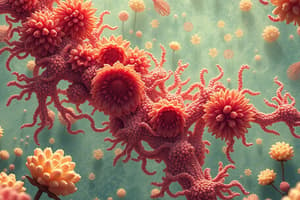Podcast
Questions and Answers
What is the primary reason why a host that dies immediately after parasite invasion may prevent the parasite from reproducing?
What is the primary reason why a host that dies immediately after parasite invasion may prevent the parasite from reproducing?
- The parasite's habitat is lost, preventing colonization of a new host (correct)
- The parasite is not adapted to the host's environment
- The host's immune system is too weak
- The host's immune system is too strong
What happens to the host if the host-parasite equilibrium is shifted to favour the parasite?
What happens to the host if the host-parasite equilibrium is shifted to favour the parasite?
- The host remains healthy
- The host's immune system is suppressed
- The host becomes ill and eventually dies (correct)
- The host becomes immune to the parasite
What is the term for the fungal partner in a lichen symbiosis?
What is the term for the fungal partner in a lichen symbiosis?
- Phycobiont
- Cyanobacterial partner
- Algal partner
- Mycobiont (correct)
How does the fungus obtain nutrients from its partner in a lichen symbiosis?
How does the fungus obtain nutrients from its partner in a lichen symbiosis?
What is the benefit of the fungus to the phycobiont in a lichen symbiosis?
What is the benefit of the fungus to the phycobiont in a lichen symbiosis?
Why was the lichen symbiosis previously considered mutualistic?
Why was the lichen symbiosis previously considered mutualistic?
What is the term for the algal or cyanobacterial partner in a lichen symbiosis?
What is the term for the algal or cyanobacterial partner in a lichen symbiosis?
What is the purpose of the haustoria in a lichen symbiosis?
What is the purpose of the haustoria in a lichen symbiosis?
What is the result of a balanced host-parasite relationship?
What is the result of a balanced host-parasite relationship?
What does the fungus use from the phycobiont in a lichen symbiosis?
What does the fungus use from the phycobiont in a lichen symbiosis?
Flashcards are hidden until you start studying
Study Notes
Microbial Ecology
- Microorganisms exist in communities with 10^10-10^17 individuals, representing at least 10^7 different taxa
- Microbial ecology describes the presence, behavior, activities, and contributions of microorganisms in their natural environments
- Microorganisms interact with each other and their environment to survive, and can adapt to environmental factors such as temperature, gases, acid, radiation, osmotic and hydrostatic pressure, and other microbes
Microbial Interactions
- Microorganisms can associate physically with other organisms in various ways, including ectosymbionts (on the surface) and endosymbionts (within another organism)
- The simplest microbial interactions involve two members, a symbiont and its host
- Interactions can be beneficial, harmful, or neutral, and can be obligatory or non-obligatory
- Microbial associations can be symbiotic (involving close nutritional relationships) or non-symbiotic
Symbiotic Relationships
- Mutualism: reciprocal benefit to both partners, an obligatory relationship in which the mutualist and host are dependent on each other
- Examples of mutualism: insects and microorganisms, aphids and Buchnera aphidicola, protozoa and termites
- Cooperation: a non-obligatory, positive interaction in which one organism provides growth factors, nutrients, or substrates to another
- Examples of cooperation: Desulfovibrio and Chromatium, cellulolytic microorganisms and nitrogen-fixing microorganisms
- Commensalism: one symbiont benefits while the other is neither harmed nor benefited
- Examples of commensalism: waste product of one microorganism as a substrate for another, nitrification (oxidation of ammonium to nitrate)
Non-Symbiotic Relationships
- Predation: a predator species attacks and usually kills its prey
- Examples of predators: Bdellovibrio, Vampirococcus, and Daptobacter
- Bdellovibrio: a motile organism that attacks Gram-negative bacterial prey, bores a hole through the outer membrane, and grows in the periplasmic space
- Predation can provide a protective, high-nutrient environment for particular prey
- Parasitism: one organism benefits from the other, usually harming the host
- Examples of parasitism: Legionella and protists, lichens (ascomycetes and green algae or cyanobacteria)
- Lichens: a controlled parasite-host relationship in which the fungus obtains nutrients from its algal or cyanobacterial partner, while providing protection and minerals in return
Studying That Suits You
Use AI to generate personalized quizzes and flashcards to suit your learning preferences.




